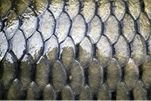

Most of us have encountered fish scales at one time or another, either when cleaning fish or when eating them. Those who work in the fish industry are aware that scales tell a lot about a fish and how it lives and what its past has been. There are growth rings on scales that are like the rings in the trunk of a tree. Counting the rings can tell us the age of the fish. There are four main types of fish scales, and each type is carefully designed for the lifestyle of the fish.
Cycloid scales are quite small and produce a very smooth surface that does not allow things to stick to it very well. Fish that inhabit areas with lots of plants, roots, or other structure need to be able to slide through those areas without things getting attached to them. Salmon and trout have this type of scales.
Ganoid scales are shiny and very hard. They are diamond shaped and resist any kind of impact. Gars are a good example of a fish with this type of scales.
 Placoid scales are found on sharks and most rays and are like tiny teeth or thorns. This type of scale is very tough and very flexible and allows rapid changes in direction.
Placoid scales are found on sharks and most rays and are like tiny teeth or thorns. This type of scale is very tough and very flexible and allows rapid changes in direction.
The most familiar type of scale for most of us is the ctenoid scales. These scales have comb-like edges that provide some protection and can secrete a mucous coating that not only lubricates the body surface but is also an antiseptic warding off bacteria and fungal infections. Just as our skin is wonderfully designed to allow us to live, heal, and function in a variety of ways, so also does the fish whose scales are beautifully fashioned to allow life to exist in a variety of water conditions.
Picture credits:
© Kondor83. Image from BigStockPhoto.com.
© vadimko. Image from BigStockPhoto.com.
